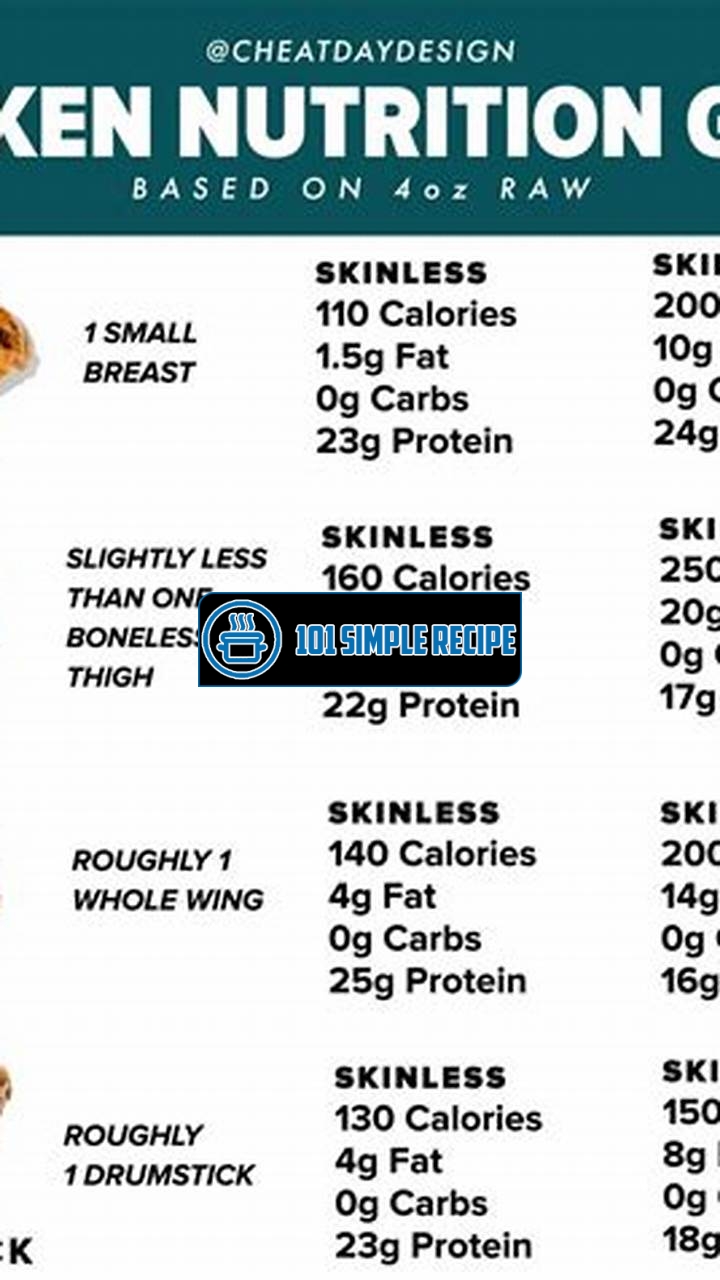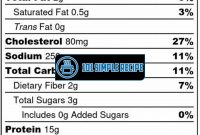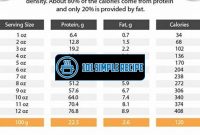Are you curious about how many calories are in a chicken breast? Well, you’ve come to the right place! In this article, we will explore the calorie content of this popular poultry option and provide you with all the information you need to make informed dietary choices. Chicken breast is a favorite among health-conscious individuals, thanks to its lean protein content and versatile nature. It is a staple in many diets, including those focused on weight loss or muscle building. So, let’s dive into the numbers and discover how many calories you can expect to find in a serving of chicken breast.

The Basics of Chicken Breast
Chicken breast is a popular and versatile cut of meat that is commonly used in a variety of dishes. It is a lean source of protein and is low in fat, making it a healthy choice for those looking to maintain a balanced diet. The culinary versatility of chicken breast allows it to be prepared in numerous ways, making it a staple ingredient in many kitchens around the world.
Nutritional Composition of Chicken Breast
Chicken breast is not only delicious but also packed with essential nutrients. A 3-ounce serving of cooked chicken breast without the skin contains approximately 165 calories. It is a low-calorie option for those trying to watch their weight or maintain a healthy lifestyle. Additionally, chicken breast is a great source of protein, with about 26 grams per serving. Protein is essential for building and repairing tissues, aiding in muscle growth, and supporting a healthy immune system.
In addition to being rich in protein, chicken breast is also a good source of vitamins and minerals. It contains significant amounts of B-vitamins, including niacin and vitamin B6, which play a crucial role in energy production and brain function. Chicken breast also provides important minerals such as iron, zinc, and phosphorus, which are essential for maintaining healthy bones, teeth, and overall bodily functions.
Moreover, chicken breast is a low-fat choice compared to other cuts of meat. It contains minimal saturated fat, which is known to raise cholesterol levels and increase the risk of heart disease. By opting for chicken breast, you can enjoy a delicious meal without worrying about excessive fat content.
Health Benefits of Chicken Breast
Chicken breast offers several health benefits that make it an excellent addition to a well-balanced diet. Firstly, as mentioned earlier, it is a great source of lean protein. Consuming an adequate amount of protein is essential for promoting satiety, maintaining healthy muscle mass, and aiding in weight management. Including chicken breast in your meals can help you feel full and satisfied for longer periods, preventing overeating and supporting weight loss goals.
In addition to being a protein powerhouse, chicken breast is also a good source of amino acids, which are the building blocks of protein. Amino acids are vital for various bodily functions, including the production of enzymes, hormones, and antibodies. Including chicken breast in your diet can help ensure you are getting the necessary amino acids for optimal health.
Furthermore, chicken breast contains several important vitamins and minerals that support overall well-being. The B-vitamins found in chicken breast play a crucial role in metabolism, brain function, and maintaining a healthy nervous system. The minerals, such as iron and zinc, help support energy production, immune function, and proper growth and development.
Cooking Methods for Chicken Breast
Chicken breast can be cooked in a variety of ways to suit different tastes and preferences. Here are a few popular cooking methods:
- Grilling: Grilling chicken breast adds a delicious smoky flavor and creates a slightly charred exterior. It is a healthy cooking method that allows excess fat to drip away from the meat.
- Baking: Baking chicken breast in the oven helps retain its moisture and allows for even cooking. It is a simple and convenient way to prepare chicken breast.
- Sautéing: Sautéing chicken breast in a small amount of oil or butter allows for quick cooking and creates a slightly crispy exterior. It is a versatile method that allows you to add various herbs, spices, and sauces for added flavor.
- Boiling: Boiling chicken breast is a straightforward method that results in moist and tender meat. This method is commonly used for preparing chicken for soups, salads, or other dishes that require cooked chicken.
Remember to cook chicken breast until it reaches an internal temperature of 165°F (74°C) to ensure it is safe to eat. Using a meat thermometer is a reliable way to gauge the doneness of chicken breast.
Overall, chicken breast is a nutritious and versatile ingredient that can be incorporated into a wide range of meals. Its low calorie and high protein content make it an excellent choice for those looking to maintain a healthy diet. Whether you choose to grill, bake, sauté, or boil it, chicken breast is sure to add flavor and nutrition to your meals.
Calories in Chicken Breast
When it comes to maintaining a healthy diet, understanding the calorie content of the foods you eat is essential. Chicken breast is a popular choice for many people due to its high protein content and lean qualities. In this article, we will explore the calorie content of chicken breast and the factors that can influence it.
Variations in Calorie Content
It is important to note that the calorie content of chicken breast can vary depending on various factors. One of the main factors is the size of the chicken breast. A larger chicken breast is likely to contain more calories compared to a smaller one. Additionally, the method of cooking can also impact the calorie content. Grilled or baked chicken breast is usually lower in calories compared to fried or breaded options.
Another factor that can contribute to variations in calorie content is the presence of skin. Chicken breast with the skin on generally has higher calorie content compared to skinless chicken breast. Removing the skin before cooking can help reduce the overall calorie intake.
Factors Affecting Calorie Content
Several factors can influence the calorie content of chicken breast. The breed of the chicken can play a role, as different breeds may have slightly different nutritional profiles. Additionally, the diet of the chicken can also impact its calorie content. Chickens that are raised on a balanced diet tend to have healthier meat with lower calorie content compared to those raised on a less nutritious diet.
The cooking method and ingredients used also affect the calorie content. For example, cooking chicken breast with added oils or sauces can significantly increase the calorie count. On the other hand, using healthier cooking methods such as grilling or baking with minimal oil can help maintain a lower calorie content.
How to Determine Calorie Content
If you want to determine the exact calorie content of chicken breast, there are a few methods you can use. Firstly, you can check the packaging if you are buying pre-packaged chicken breast. The packaging usually provides information on the calorie content per serving.
Alternatively, you can use online resources or smartphone applications that provide nutritional information for various foods. These tools often allow you to input the weight or portion size of the chicken breast to calculate the calorie content accurately.
It is important to note that these methods provide estimates, and the actual calorie content may vary slightly. However, they can still be helpful in managing your overall calorie intake and making informed dietary choices.
In conclusion, the calorie content of chicken breast can vary depending on various factors such as size, cooking method, and the presence of skin. It is essential to be mindful of these factors and determine the calorie content accurately to maintain a healthy diet. By understanding the calorie content of chicken breast, you can make informed decisions and include it as a part of your balanced meal plan.
Chicken Breast and Weight Management
Chicken breast is a versatile and healthy protein option that can be incorporated into a balanced diet for weight loss or maintenance. Its low calorie and high protein content make it a popular choice among individuals looking to shed pounds or build lean muscle mass.
Chicken Breast in a Weight Loss Plan
If you’re trying to lose weight, chicken breast can be an excellent addition to your meal plan. It is low in calories, with approximately 165 calories per 3-ounce serving. This makes it a filling and satisfying option that won’t derail your calorie goals.
In addition to being low in calories, chicken breast is also high in protein. Protein is known to be more satiating than carbohydrates or fats, meaning it keeps you feeling full for longer periods of time. This can help curb cravings and reduce overall calorie intake.
Furthermore, chicken breast is a lean source of protein, meaning it contains very little fat. By opting for skinless chicken breast, you can minimize your saturated fat intake and make a heart-healthy choice. Remember, fat contains more than twice the calories per gram compared to protein or carbohydrates.
Chicken Breast in a Muscle-Building Diet
If you’re looking to build muscle mass, chicken breast should be a staple in your diet. It is not only high in protein but also contains essential amino acids that are vital for muscle repair and growth.
One 3-ounce serving of chicken breast provides approximately 26 grams of protein, making it an ideal choice for post-workout meals. Protein is crucial for repairing and rebuilding muscle tissue after intense exercise, promoting muscle growth and recovery. Including chicken breast in your muscle-building diet can assist in achieving your fitness goals.
It is worth noting that chicken breast is a complete protein, meaning it contains all the essential amino acids your body needs. These amino acids cannot be produced by your body and must be obtained through your diet.
Portion Control and Calorie Tracking
While chicken breast can be a healthy addition to your diet, it is important to practice portion control and track your calorie intake. Even though it is low in calories, consuming large portions can still lead to weight gain.
When serving chicken breast, aim for a 3-ounce portion, which is roughly the size of a deck of cards. This will provide you with about 165 calories. Pair it with a variety of vegetables and whole grains to create a balanced meal.
Tracking your calorie intake can also help you stay on track with your weight management goals. There are several apps and websites available that allow you to input your food intake and track your calorie consumption. This can help you make informed decisions about your meals and ensure you stay within your calorie target.
Incorporating chicken breast into your weight management plan can be a smart choice. Its low calorie and high protein content make it a filling and satisfying option for those looking to shed pounds. Whether you’re aiming for weight loss or muscle building, chicken breast is a nutritious addition to any diet. Just remember to practice portion control and track your calories to achieve your goals effectively. ️
Recipe for peanut butter cups can be a tasty treat to balance out the low-calorie chicken breast.
Comparing Chicken Breast Cuts
When it comes to counting calories, understanding the differences between various chicken breast cuts is essential. Not only does it affect the number of calories in your meals, but it also plays a role in the taste and texture of your dishes. In this article, we will explore the calorie differences between skinless vs. skin-on chicken breast, bone-in vs. boneless chicken breast, and chicken breast fillet vs. whole chicken breast. Let’s dive in and discover how these cuts differ and how they can be used in a variety of recipes.
Skinless vs. Skin-On Chicken Breast
The first aspect we will compare is skinless vs. skin-on chicken breast. Skinless chicken breast refers to the removal of the skin before cooking, while skin-on chicken breast retains the skin during the cooking process. The calorie difference between these two cuts is primarily due to the fat content in the chicken skin.
Skinless Chicken Breast: Skinless chicken breast is a lean and low-calorie option. A skinless, boneless chicken breast weighing around 100 grams contains approximately 165 calories. This makes it a popular choice for those watching their calorie intake or following a healthy eating plan.
Skin-On Chicken Breast: On the other hand, skin-on chicken breast has a slightly higher calorie count. A 100-gram serving of skin-on chicken breast contains roughly 197 calories. The skin adds flavor and moisture to the meat but also increases its calorie content. However, it’s worth noting that the skin can easily be removed after cooking to reduce the calorie intake.
Bone-In vs. Boneless Chicken Breast
In addition to the skin, bones also contribute to the calorie differences in chicken breast cuts. Let’s compare bone-in vs. boneless chicken breast and examine their calorie variations.
Boneless Chicken Breast: Boneless chicken breast is a versatile choice and is readily available in most grocery stores. It is also slightly lower in calories compared to bone-in chicken breast. A 100-gram serving of boneless chicken breast contains approximately 165 calories. This makes it an excellent option for individuals looking to reduce their calorie intake while enjoying the deliciousness of chicken.
Bone-In Chicken Breast: On the other hand, bone-in chicken breast contains more calories due to the presence of bones. A 100-gram serving of bone-in chicken breast contains roughly 172 calories. Although the difference is not significant, it’s essential to consider if you are specifically counting your calorie intake.
Chicken Breast Fillet vs. Whole Chicken Breast
Lastly, let’s explore the calorie differences between chicken breast fillet and whole chicken breast. Both cuts have their own unique qualities and uses in various dishes.
Chicken Breast Fillet: Chicken breast fillet refers to a boneless cut that is generally sliced thinly for quick and even cooking. It is a popular choice for stir-fries, salads, and sandwiches. A 100-gram serving of chicken breast fillet contains approximately 165 calories. This cut is lean, flavorful, and a great option for those watching their calorie intake.
Whole Chicken Breast: Whole chicken breast, as the name suggests, includes both the tenderloin and the fillet. It is a larger cut and is often used in recipes that require more substantial portions of chicken. A 100-gram serving of whole chicken breast contains roughly 165 calories. This cut offers more versatility in terms of cooking methods and can be used in baking, grilling, or roasting.
In conclusion, understanding the calorie differences between various chicken breast cuts allows you to make more informed choices in your cooking. Whether you prefer skinless, boneless, or chicken breast fillet, there are options to suit your dietary needs and taste preferences. So next time you’re planning a meal, consider how these cuts can be used to create a delicious and calorie-conscious dish.
Garlic bread stick recipe is a delicious side dish that goes well with chicken breast.
Tips for Preparing and Cooking Chicken Breast
When it comes to cooking chicken breast, there are a few expert tips you can follow to ensure your dishes are flavorful and low in calories. Whether you’re grilling, baking, or sautéing, these tips will help you achieve the perfect chicken breast every time.
- Trim the fat: Before you start cooking, it’s important to trim any excess fat from the chicken breast. This will help reduce the calorie content and make the dish healthier.
- Pound it thin: If you want your chicken breast to cook evenly and quickly, consider pounding it thin. This technique also tenderizes the meat, resulting in a more delicious and juicy final dish.
- Use a meat thermometer: To ensure your chicken breast is cooked to perfection, invest in a meat thermometer. This will help you avoid undercooked or overcooked chicken and maintain the optimal temperature of 165°F (74°C).
- Add flavor with marinades: Marinating the chicken breast before cooking can infuse it with extra flavor. Try using a mixture of herbs, spices, and acid-based ingredients like lemon juice or vinegar. This not only enhances the taste but also helps tenderize the meat.
- Experiment with healthy cooking methods: Instead of frying the chicken breast, try healthier cooking methods such as grilling, baking, or poaching. These methods require less oil or fat, making the dish lower in calories and healthier overall.
Marinating Techniques for Chicken Breast
Marinating is a fantastic technique for adding flavor and moisture to chicken breast. Here are a few marinating techniques you can try:
- Classic marinade: Create a simple marinade by combining olive oil, garlic, lemon juice, salt, and pepper. Let the chicken breast marinate for at least 30 minutes before cooking.
- Yogurt-based marinade: Mix Greek yogurt with spices like cumin, paprika, and turmeric. Add a dash of lemon juice and let the chicken breast marinate for a couple of hours. The yogurt helps tenderize the meat and keeps it moist during cooking.
- Citrus marinade: Combine orange juice, lime juice, soy sauce, and honey. This sweet and tangy marinade works well with chicken breast and adds a refreshing flavor to the dish.
Healthy Cooking Methods for Chicken Breast
Choosing healthier cooking methods is essential for keeping your chicken breast dishes low in calories. Here are a few methods to try:
- Grilling: Grilling chicken breast creates a smoky flavor and delicious char that enhances any dish. Brush the chicken with a little olive oil before grilling to prevent sticking.
- Baking: Baking chicken breast in the oven is a foolproof method. Season the chicken with your choice of spices and herbs, then bake it at 400°F (200°C) until it reaches the desired internal temperature.
- Poaching: Poaching involves gently simmering the chicken breast in liquid until it’s cooked through. Use low-sodium broth or water infused with herbs and spices for added flavor.
Flavorful Seasonings and Accompaniments
When it comes to adding flavor to your chicken breast dishes, the right seasonings and accompaniments can make all the difference. Here are some flavorful options:
- Herbs and spices: Experiment with different herbs and spices like rosemary, thyme, paprika, or cumin to enhance the taste of your chicken breast.
- Healthy sauces: Opt for lighter sauces like homemade salsa, Greek yogurt-based sauces, or citrus-based dressings to keep the calorie count low.
- Fresh garnishes: Sprinkle fresh herbs like parsley or cilantro on top of your cooked chicken breast for an added burst of flavor.
Remember: When it comes to cooking chicken breast, the possibilities are endless. You can try different marinades, cooking methods, and seasonings to create delicious and healthy dishes. Don’t be afraid to get creative in the kitchen!
Cookie in a mug recipe is a quick and easy dessert option to enjoy after a healthy chicken breast meal.
Frequently Asked Questions
Thank you for taking the time to read our article about how many calories are in a chicken breast. We hope you found the information useful and informative. If you have any more questions or if there’s anything else you’d like to know, please don’t hesitate to reach out. We’re here to help!
| No. | Questions | Answers |
|---|---|---|
| 1. | How many calories are there in a chicken breast? | A skinless, boneless chicken breast typically contains around 165-200 calories per 100 grams. However, the exact calorie count can vary depending on the size and cooking method. It’s always best to refer to the packaging or use a food tracking app for more accurate results. |
| 2. | Is chicken breast a good source of protein? | Yes, chicken breast is a lean source of protein. It contains all essential amino acids and is low in fat. Including chicken breast in your diet can help you meet your protein needs and support muscle growth and repair. |
| 3. | Can I incorporate chicken breast into a weight loss diet? | Absolutely! Chicken breast is a great option for weight loss. It’s low in calories, high in protein, and can help you feel full and satisfied. Just remember to watch your portion sizes and pair it with nutritious vegetables and whole grains for a balanced meal. |
| 4. | Should I opt for skinless chicken breast? | It’s generally recommended to choose skinless chicken breast for a healthier option. Chicken skin contains more fat and calories. Removing the skin can significantly reduce the overall calorie content of the chicken breast. |
| 5. | Are there any other health benefits of eating chicken breast? | Yes, chicken breast is not only a good source of protein but also provides essential vitamins and minerals such as vitamin B6, niacin, phosphorus, and selenium. These nutrients play important roles in maintaining overall health and supporting various bodily functions. |
| 6. | What are some delicious ways to prepare chicken breast? | There are countless delicious ways to prepare chicken breast! You can grill it, bake it, sauté it, or even make it into a flavorful stir-fry. Experiment with different herbs, spices, and marinades to add variety and enhance the taste of your chicken breast dishes. |
Thank You for Reading!
We hope you found our article about how many calories are in a chicken breast informative and helpful. If you have any more questions or if there’s anything else you’d like to know, please don’t hesitate to visit our website again in the future. We’re constantly updating our content to provide you with the latest and most accurate information. Don’t forget to check out our other articles for more health and nutrition tips. Stay healthy and happy!
Jump to Recipe
Chicken Breast Delight

Learn how many calories are in a chicken breast and discover the health benefits of incorporating this lean protein into your diet. Find delicious recipes and cooking tips here.
- 4 boneless (skinless chicken breasts)
- 1 tablespoon olive oil
- 1 teaspoon salt
- 1/2 teaspoon black pepper
- 1 teaspoon garlic powder
- 1 teaspoon paprika
- Preheat the oven to 400°F (200°C).
- Rub the chicken breasts with olive oil and season with salt, pepper, garlic powder, and paprika.
- Place the seasoned chicken breasts on a baking sheet.
- Bake for 20 minutes or until the chicken is cooked through and reaches an internal temperature of 165°F (74°C).
- Remove from the oven and let the chicken rest for a few minutes before slicing and serving.






